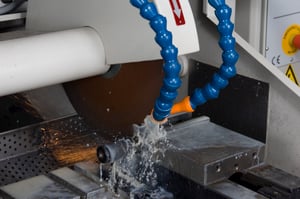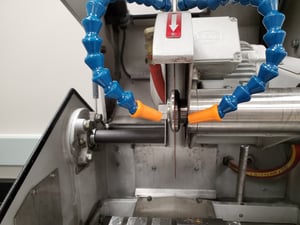 My cuts are not as quick or clean as I would like them to be, or my abrasive sectioning wheels wear out too quickly.
My cuts are not as quick or clean as I would like them to be, or my abrasive sectioning wheels wear out too quickly.
It’s frustrating when your cuts take far too long, and even worse when the sectioned specimen is rough and requires excessive amounts of grinding. A consistently sharp blade cuts best, but if it feels like you’re always replacing the blade, maybe the type of blade itself is the problem.
To understand problems with sectioning wheels, it’s important to understand how an abrasive blade works. The sharp abrasive particles on the blade cut through the specimen and become dull with use. There are two ways to remedy dull particles:
- Fracture dull particles to create new sharp cutting edges
- Eject dull particles to allow fresh, sharp particles behind them to create a revitalized cutting surface
You might think the best blade, therefore, would have easily fractured abrasive particles and would be created with a weak binder to allow those particles to slough off as the blade is used. However, there is a finite number of particles in a blade, and a finite number of times particles can be broken. The “best blade” here would be great when it was new, but it would quickly sacrifice itself and wear away.
Selecting a blade is actually a balancing act between the SPEED, EASE, and QUALITY of the cut and the LIFESPAN of the blade. These factors come down to the different variables for sectioning blades.

- Abrasive: The size and material of the abrasive used affects the speed and quality of the cut. Silicon carbide abrasive particles are harder than aluminum oxide particles, but break more easily, so they wear out quicker.
- Binder: The strength of the binder affects how long the abrasive particles stay in place in the blade. A weak binder allows dull abrasive particles to be ejected more easily and therefore stays “sharp” longer.
- Diameter: The size of the blade used affects the ease of the cut and the lifespan of the blade. A larger diameter blade lasts longer, but it costs more and is more prone to “wandering” during a cut.
- Thickness: The thickness of a blade used affects the quality of the cut. A thicker blade generates more heat during a cut and destroys more of the item being cut. It is, however, stiffer and less apt to wander and/or fracture during a cut.
Most blade suppliers publish guidelines aimed at providing users with a starting point for selecting a blade. These guidelines may be fairly vague (e.g. “For Cutting Soft-to-Medium-Soft Steels”) or quite specific (e.g. “For Sectioning Hardened Carbon Steels - Hardness Range: 55-65 HRC”). In any case, the suggestion is just a starting point.
For example, if the suggested blade makes a great cut in a short period of time, but wears out very quickly, try running a trial using a blade with a stronger bond, such as a blade designed to cut materials softer than the material at hand. If this blade also makes great cuts and lasts a little longer than the first, it might be wise to try a third blade; one with a stronger bond, meant for even softer materials. Keep testing until you find a blade that can balance the quality of the cut you need while minimizing blade consumption. If you are still having trouble finding the right blade for your sectioning, let us know. Contact us at met_tips@leco.com, and we will have an expert reach out to help you get your lab running smoothly once again.


